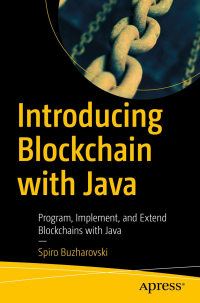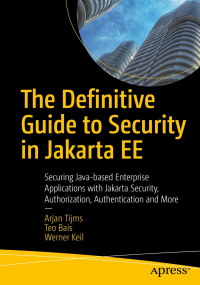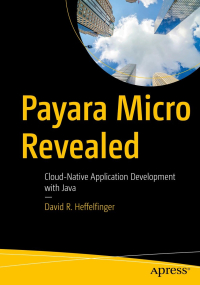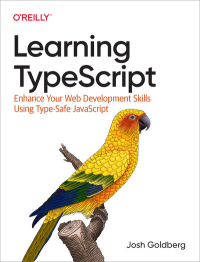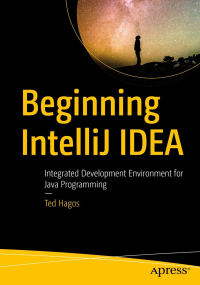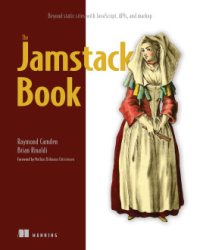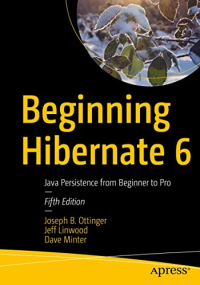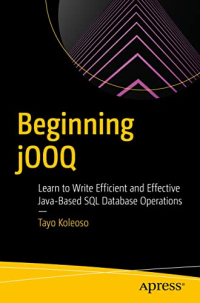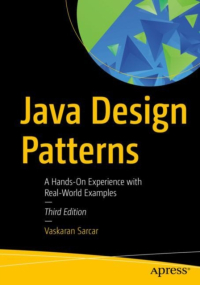Java eBooks
Developing High-Frequency Trading Systems
The world of trading markets is complex, but it can be made easier with technology. Sure, you know how to code, but where do you start? What programming language do you use? How do you solve the problem of latency? This book answers all these questions. It will help you navigate the world of algorithmic trading and show you how to build a high-frequency trading (HFT) system from complex technological components, supported by accurate data. Starting off with an introduction to HFT, exchanges, and the critical components of a trading system, this book quickly moves on to the nitty-gritty of optimizing hardware and your operating system for low-latency trading, such as bypassing the kernel, memory allocation, and the danger of context switching. Monitoring your system's performance is vital, so you'll also focus on logging and statistics. As you move beyond the traditional HFT programming languages, such as C++ and Java you'll learn how to use Python to achieve high levels of pe ...
The world of trading markets is complex, but it can be made easier with technology. Sure, you know how to code, but where do you start? What programming language do you use? How do you solve the problem of latency? This book answers all these questions. It will help you navigate the world of algorithmic trading and show you how to build a high-frequency trading (HFT) system from complex technological components, supported by accurate data. Starting off with an introduction to HFT, exchanges, and the critical components of a trading system, this book quickly moves on to the nitty-gritty of optimizing hardware and your operating system for low-latency trading, such as bypassing the kernel, memory allocation, and the danger of context switching. Monitoring your system's performance is vital, so you'll also focus on logging and statistics. As you move beyond the traditional HFT programming languages, such as C++ and Java you'll learn how to use Python to achieve high levels of pe ...
React and React Native, 4th Edition
Over the years, React and React Native has proven itself among JavaScript developers as a popular choice for a complete and practical guide to the React ecosystem. This fourth edition comes with the latest features, enhancements, and fixes to align with React 18, while also being compatible with React Native. It includes new chapters covering critical features and concepts in modern cross-platform app development with React. From the basics of React to popular components such as Hooks, GraphQL, and NativeBase, this definitive guide will help you become a professional React developer in a step-by-step manner. You'll begin by learning about the essential building blocks of React components. As you advance through the chapters, you'll work with higher-level functionalities in application development and then put your knowledge to work by developing user interface components for the web and native platforms. In the concluding chapters, you'll learn how to bring your application toget ...
Over the years, React and React Native has proven itself among JavaScript developers as a popular choice for a complete and practical guide to the React ecosystem. This fourth edition comes with the latest features, enhancements, and fixes to align with React 18, while also being compatible with React Native. It includes new chapters covering critical features and concepts in modern cross-platform app development with React. From the basics of React to popular components such as Hooks, GraphQL, and NativeBase, this definitive guide will help you become a professional React developer in a step-by-step manner. You'll begin by learning about the essential building blocks of React components. As you advance through the chapters, you'll work with higher-level functionalities in application development and then put your knowledge to work by developing user interface components for the web and native platforms. In the concluding chapters, you'll learn how to bring your application toget ...
Introducing Blockchain with Java
Create your own crypto currency by implementing blockchain technology using Java. This step-by-step guide will teach you how to create a user interface using Java FX and implement SQLite DB using JDBC Driver for the blockchain. Introducing Blockchain with Java includes numerous exercises and test questions to help you solidify what you have learned as you progress through the book, and provides ideas on expanding the codebase to make it your own. You will have access to a fully-functioning repository with Java code. Upon completing this book, you will have the knowledge necessary to program your own blockchains with Java and you will have a completed project for your portfolio. ...
Create your own crypto currency by implementing blockchain technology using Java. This step-by-step guide will teach you how to create a user interface using Java FX and implement SQLite DB using JDBC Driver for the blockchain. Introducing Blockchain with Java includes numerous exercises and test questions to help you solidify what you have learned as you progress through the book, and provides ideas on expanding the codebase to make it your own. You will have access to a fully-functioning repository with Java code. Upon completing this book, you will have the knowledge necessary to program your own blockchains with Java and you will have a completed project for your portfolio. ...
The Definitive Guide to Security in Jakarta EE
Refer to this definitive and authoritative book to understand the Jakarta EE Security Spec, with Jakarta Authentication & Authorization as its underlying official foundation. Jakarta EE Security implementations are discussed, such as Soteria and Open Liberty, along with the build-in modules and Jakarta EE Security third-party modules, such as Payara Yubikey & OIDC, and OmniFaces JWT-Auth. The book discusses Jakarta EE Security in relation to SE underpinnings and provides a detailed explanation of how client-cert authentication over HTTPS takes place, how certifications work, and how LDAP-like names are mapped to caller/user names. General (web) security best practices are presented, such as not storing passwords in plaintext, using HTTPS, sanitizing inputs to DB queries, encoding output, and explanations of various (web) attacks and common vulnerabilities are included. Practical examples of securing applications discuss common needs such as letting users explicitly log in, sign u ...
Refer to this definitive and authoritative book to understand the Jakarta EE Security Spec, with Jakarta Authentication & Authorization as its underlying official foundation. Jakarta EE Security implementations are discussed, such as Soteria and Open Liberty, along with the build-in modules and Jakarta EE Security third-party modules, such as Payara Yubikey & OIDC, and OmniFaces JWT-Auth. The book discusses Jakarta EE Security in relation to SE underpinnings and provides a detailed explanation of how client-cert authentication over HTTPS takes place, how certifications work, and how LDAP-like names are mapped to caller/user names. General (web) security best practices are presented, such as not storing passwords in plaintext, using HTTPS, sanitizing inputs to DB queries, encoding output, and explanations of various (web) attacks and common vulnerabilities are included. Practical examples of securing applications discuss common needs such as letting users explicitly log in, sign u ...
Payara Micro Revealed
Develop, configure, and deploy Java cloud-native applications using Payara Micro. This book demystifies Java cloud-native application development using standard Microprofile APIs and covers Payara-specific features such as automatic clustering and application initialization performance improvements. You will learn how to improve startup performance by taking advantage of class data sharing, and configure cloud-native applications via standard development tools such as Maven and Gradle. The book also clarifies how to develop functionality necessary in a cloud environment, such as health checks and request tracing, using MicroProfile APIs. The book begins by showing how to develop microservices using RESTful web services, followed by how to create microservice clients using MicroProfile and the REST client API. Dependency Injection via Jakarta Context and Dependency Injection (CDI) is also covered. Various approaches to application configuration are covered as well, incl ...
Develop, configure, and deploy Java cloud-native applications using Payara Micro. This book demystifies Java cloud-native application development using standard Microprofile APIs and covers Payara-specific features such as automatic clustering and application initialization performance improvements. You will learn how to improve startup performance by taking advantage of class data sharing, and configure cloud-native applications via standard development tools such as Maven and Gradle. The book also clarifies how to develop functionality necessary in a cloud environment, such as health checks and request tracing, using MicroProfile APIs. The book begins by showing how to develop microservices using RESTful web services, followed by how to create microservice clients using MicroProfile and the REST client API. Dependency Injection via Jakarta Context and Dependency Injection (CDI) is also covered. Various approaches to application configuration are covered as well, incl ...
Learning TypeScript
TypeScript has conquered the world of JavaScript: it's one of the world's fastest growing and most popular languages across developer surveys, widely used in consumer and business companies alike, and frequently credited for helping massive web applications scale. But what is TypeScript? How does it work, why does it work, and how can we use it? Learning TypeScript takes beginner to intermediate JavaScript programmers from knowing nothing about "types" or a "type system" to full mastery of the fundamentals of TypeScript. It's more than a means to find bugs and typos - it's a useful system for declaring the way our JavaScript should work and helping us stick to it. You'll learn how TypeScript: interacts with JavaScript; analyzes and understands code; augments your existing development pattern; helps you document your code; works with IDEs to provide refactoring tools; assists local development in refactoring code; helps you develop more quickly with fewer bugs. ...
TypeScript has conquered the world of JavaScript: it's one of the world's fastest growing and most popular languages across developer surveys, widely used in consumer and business companies alike, and frequently credited for helping massive web applications scale. But what is TypeScript? How does it work, why does it work, and how can we use it? Learning TypeScript takes beginner to intermediate JavaScript programmers from knowing nothing about "types" or a "type system" to full mastery of the fundamentals of TypeScript. It's more than a means to find bugs and typos - it's a useful system for declaring the way our JavaScript should work and helping us stick to it. You'll learn how TypeScript: interacts with JavaScript; analyzes and understands code; augments your existing development pattern; helps you document your code; works with IDEs to provide refactoring tools; assists local development in refactoring code; helps you develop more quickly with fewer bugs. ...
Beginning IntelliJ IDEA
Get started quickly with IntelliJ, from installation to configuration to working with the source code and more. This tutorial will show you how to leverage IntelliJ's tools to develop clean, efficient Java applications. Author Ted Hagos will first walk you through buidling your first Java applications using IntelliJ. Then, he'll show you how to analyze your application, top to bottom; using version control and tools that allow you expand your application for big data or data science applications and more. You'll also learn some of the IDE's advanced features to fully maximize your application's capabilities. The last portion of the book focuses on application testing and deployment, and language- and framework- specific guidelines. After reading this book and working through its freely available source code, you'll be up to speed with this powerful IDE for today's Java development. ...
Get started quickly with IntelliJ, from installation to configuration to working with the source code and more. This tutorial will show you how to leverage IntelliJ's tools to develop clean, efficient Java applications. Author Ted Hagos will first walk you through buidling your first Java applications using IntelliJ. Then, he'll show you how to analyze your application, top to bottom; using version control and tools that allow you expand your application for big data or data science applications and more. You'll also learn some of the IDE's advanced features to fully maximize your application's capabilities. The last portion of the book focuses on application testing and deployment, and language- and framework- specific guidelines. After reading this book and working through its freely available source code, you'll be up to speed with this powerful IDE for today's Java development. ...
The Jamstack Book
Jamstack sites use JavaScript, APIs, and Markup to create fast, dynamic pages without the overhead of heavyweight frameworks. The Jamstack Book is your essential guide to this exciting new web architecture. Written by renowned Jamstack experts Raymond Camden and Brian Rinaldi, it's filled with real-world projects to develop and hone your skills. You'll learn how to lay out and generate a site, set up your own CMS, and add dynamic features like user logins and search functionality. Confusing jargon is demystified. Plus, you'll get the chance to try out different static site generators and find the one that works best for you. Pick up this book today, and you'll discover how the Jamstack answers your need for speed and simplicity. JavaScript, APIs, and pre-rendered Markup put the JAM in Jamstack. This modern web architecture delivers the quick load times of static sites along with the dynamic functionality you need for user-friendly interactive features. Built with lightweight stan ...
Jamstack sites use JavaScript, APIs, and Markup to create fast, dynamic pages without the overhead of heavyweight frameworks. The Jamstack Book is your essential guide to this exciting new web architecture. Written by renowned Jamstack experts Raymond Camden and Brian Rinaldi, it's filled with real-world projects to develop and hone your skills. You'll learn how to lay out and generate a site, set up your own CMS, and add dynamic features like user logins and search functionality. Confusing jargon is demystified. Plus, you'll get the chance to try out different static site generators and find the one that works best for you. Pick up this book today, and you'll discover how the Jamstack answers your need for speed and simplicity. JavaScript, APIs, and pre-rendered Markup put the JAM in Jamstack. This modern web architecture delivers the quick load times of static sites along with the dynamic functionality you need for user-friendly interactive features. Built with lightweight stan ...
Beginning Hibernate 6, 5th Edition
Get started with Hibernate, an open source Java persistence layer and gain a clear introduction to the current standard for object-relational persistence in Java. This updated edition includes the new Hibernate 6.0 framework which covers new configuration, new object relational mapping changes, and enhanced integration with the more general Spring, Boot and Quarkus and other Java frameworks. The book keeps its focus on Hibernate without wasting time on nonessential third-party tools, so you'll be able to immediately start building transaction-based engines and applications. Experienced authors Joseph Ottinger with Dave Minter and Jeff Linwood provide more in-depth examples than any other book for Hibernate beginners. They present their material in a lively, example-based manner - not a dry, theoretical, hard-to-read fashion. ...
Get started with Hibernate, an open source Java persistence layer and gain a clear introduction to the current standard for object-relational persistence in Java. This updated edition includes the new Hibernate 6.0 framework which covers new configuration, new object relational mapping changes, and enhanced integration with the more general Spring, Boot and Quarkus and other Java frameworks. The book keeps its focus on Hibernate without wasting time on nonessential third-party tools, so you'll be able to immediately start building transaction-based engines and applications. Experienced authors Joseph Ottinger with Dave Minter and Jeff Linwood provide more in-depth examples than any other book for Hibernate beginners. They present their material in a lively, example-based manner - not a dry, theoretical, hard-to-read fashion. ...
Beginning jOOQ
Learn to use the jOOQ library to manage SQL database operations in Java and JVM applications. This book walks you through what JOOQ is, how to install and get started with it, and then gets you working with it. Practical examples and case studies demonstrate how jOOQ offers a more efficient and versatile alternative to Object-Relational Mapping frameworks like Hibernate and JPA, while providing a natural, native-SQL feeling for the developer. You'll see how to maximize the full potential of your SQL database with advanced query syntax and functions with this lightweight, SQL-friendly framework. Come see how you can use high performance approaches like reactive, data streaming and cloud-native programming to get data from SQL tables. Never write another incorrect SQL statement again and protect your application from SQL injection with the strong typing and inbuilt controls in jOOQ. Learn how to add jOOQ to your existing Hibernate, Spring Boot or Quarkus applications. When ...
Learn to use the jOOQ library to manage SQL database operations in Java and JVM applications. This book walks you through what JOOQ is, how to install and get started with it, and then gets you working with it. Practical examples and case studies demonstrate how jOOQ offers a more efficient and versatile alternative to Object-Relational Mapping frameworks like Hibernate and JPA, while providing a natural, native-SQL feeling for the developer. You'll see how to maximize the full potential of your SQL database with advanced query syntax and functions with this lightweight, SQL-friendly framework. Come see how you can use high performance approaches like reactive, data streaming and cloud-native programming to get data from SQL tables. Never write another incorrect SQL statement again and protect your application from SQL injection with the strong typing and inbuilt controls in jOOQ. Learn how to add jOOQ to your existing Hibernate, Spring Boot or Quarkus applications. When ...
Java Design Patterns, 3rd Edition
Use the step-by-step approach of this book to learn and implement design patterns in real-world applications. It focuses on classical design patterns with Java 17 and Eclipse (2021-09). In addition to Gang of Four (GoF) design patterns, the book covers popular and alternative design patterns and includes criticisms of design patterns in a chapter on anti-patterns. The book is divided into four parts. Part one covers the SOLID design principles and the Simple Factory pattern. Part two covers the 23 (GoF) design patterns, including the creational patterns, structural patterns, and behavioral patterns. Part three covers alternative design patterns, including the Null Object pattern, and the model-view-controller (MVC) pattern. Part four covers criticisms of design patterns with a quick overview of anti-patterns. It also includes a chapter on FAQs on design patterns. Each pattern is explained with real-world examples and the pros and cons of each of the design patterns are di ...
Use the step-by-step approach of this book to learn and implement design patterns in real-world applications. It focuses on classical design patterns with Java 17 and Eclipse (2021-09). In addition to Gang of Four (GoF) design patterns, the book covers popular and alternative design patterns and includes criticisms of design patterns in a chapter on anti-patterns. The book is divided into four parts. Part one covers the SOLID design principles and the Simple Factory pattern. Part two covers the 23 (GoF) design patterns, including the creational patterns, structural patterns, and behavioral patterns. Part three covers alternative design patterns, including the Null Object pattern, and the model-view-controller (MVC) pattern. Part four covers criticisms of design patterns with a quick overview of anti-patterns. It also includes a chapter on FAQs on design patterns. Each pattern is explained with real-world examples and the pros and cons of each of the design patterns are di ...


